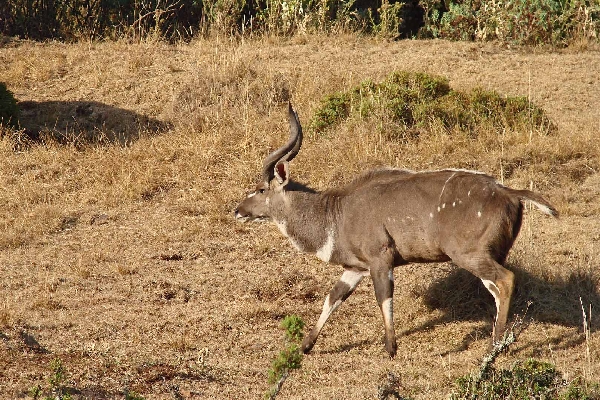BALE MOUNTAINS NATIONAL
PARK
 |
 |
Bale Mountains National park is a magnificent high altitude plateau
with numerous dramatic volcanic plugs, seasonal tiny alpine lakes and
cascading mountain streams. Located at about 400 km from Addis Ababa,
it is stretched over an area of 2,400 sq kms, which has altitude ranges
from 1500m-4377m above sea level. Being the largest Afro Alphine habitat
park in Africa, Bale mountain national park offers the following major
features of attraction. It gives chances of viewing about 46 mammals and
200 bird species and vegetation of unspoiled wonderland including various
tree species and precious endemic mammals, namely Red Fox, Mountain Nyala,
and Menelik's Bushback. Its climate is mostly very cold with rainfall
and damp cloud with rare sparking blue sky. The best season of walking,
trekking and camping in the park to view the endemic life and enjoy other
tourist activities in the astonishing vast alphine areas is the dry season,
which is from November to January. Visitors can enjoy the habitat at all
seasons with warm and weather proof clothing. The three main divisions
of the park, the northern area –Dinsho, the
central alphine part-Sannate, and the southern forest area-Haranna offer
distinct features. Dinsho area is the perfect
site of viewing Mountain Nyala and Menelik’s Bushbuck, etc. Tourists can
visit the head quarters and the museum of the park here at Dinsho and
get lodge service and relevant information about the park. Sannate:
nick-named as “the Island in the Air”, is a high plateau souring up to
4000m on top of which the second highest peak in Ethiopia, Mount Tullu
Dimtu (4377m above sea level), among many, is found. An all weather road
from Goba to Dallo Manna passes over this plateau. The seasonal tiny alphline
lakes, some rare birds, and above all, the Red Fox, which is the top tourist
attraction mostly specific to Bale mountain is spotted here. The
southern Harrana area is an area of lower altitude covered with
dense tropical forest. The road penetrating Sannate and Haranna forest
connects Goba with Dallo Manna. Bush pig, Africa hunting dog, giant forest
hog, spotted hyena, lion, leopards, colobus monkey,etc. do abound in Haranna
area.
Camping at Dinsho and at different
sites in the park gives great delight to tourists. Marvelous Ethiopia Tours
arranges every thing in Addis Ababa for your trips. The Bekele Mola hotel
(at Robe) and the Wabe Shebele hotel (at Gobba), welcome tourists with
accommodation and catering services.
SOF UMAR CAVE
Sof Umar Cave, one of the world’s biggest,
Africa’s largest cave, and marvelous underground is located in Goro District
of Bale Zone at a distance of 110km from the Zone’s capital Robe and 40
kms from the nearest town Goro. The cave’s major attraction features include.
The cave’s area which is typically characterized by flat topography and
a deep gorge cut by River Web which forms the cave, and in particular
the Ayyo-Mako cliff gate of river entrance is the right spot where visitors
start cave expedition while the Hulluqa is the resurgence of both tourist
and the river from the cave. The beauty of the cave comes from the untouched
and savage aspects of the huge main passages, the very special shape of
the sections of the galleries, the white color of the lime stones basalt
that form the walls, the great number of entrances, the bewitching noise
of the river, labyrinthine morphology of the galleries network and the
presence of the many bats etc. The 42 internal indurances and its total
passages distance of 16km, its 1.7kms tourist line, which crosses the
river seven times and takes tourists about an hour’s walking. Sof Umar
cave is a reputed historical Islamic heritage attributed to the sufist
Sheikh Safiyyullah Umar (abbreviated as “Sof Umar”) from whom the name
of the cave is originated. The Sheikh is said to be the nephew as well
as the disciple of Sheikh Husein. He lived and worshiped Allah in the
cave and taught Islam to his followers many centuries ago. The cave thus
is one of the venerated monuments of religious history that predate the
arrival of Islam in Bale. The persent cultural practice of offering prayers
and sacrifices by the pilgrim twice a year celebrates events of religious
ceremony gives opportunity to experience history and culture.

